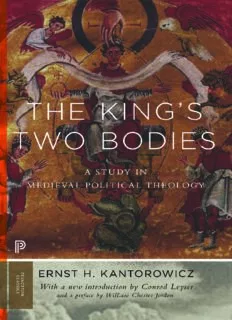
The King’s Two Bodies: A Study in Medieval Political Theology PDF
Preview The King’s Two Bodies: A Study in Medieval Political Theology
The King’s Two Bodies T H E K I N G ’S T W O B O D IE S A Study in Mediaeval Political Theology BY ERNST H. KANTOROWICZ WITH A NEW INTRODUCTION BY CONRAD LEYSER PRINCETON UNIVERSITY PRESS PRINCETON AND OXFORD Published by Princeton University Press, 41 William Street, Princeton, New Jersey In the United Kingdom: Princeton University Press 6 Oxford Street, Woodstock, Oxfordshire OX20 1TR Copyright © 1957, by Princeton University Press; Copyright renewed 1985 by Princeton University Press Preface by William Chester Jordan copyright © 1997 by Princeton University Press Introduction to the Princeton Classics Edition by Conrad Leyser © 2016 by Princeton University Press All Rights Reserved First Princeton Classics Edition printing, with a new introduction by Conrad Leyser, 2016 Seventh paperback printing, with a new preface by William Chester Jordan, 1997 Paper ISBN: 978-0-691-16923-1 Library of Congress Control Number: 2016934635 press.princeton.edu Printed on acid-free paper ^ Printed in the United States of America 10 9 8 7 6 5 4 3 2 1 D. M. M A X IM I R A D IN (MDCCCLXXX-MCML) S A C R U M CONTENTS INTRODUCTION TO THE PRINCETON CLASSICS EDITION ix PREFACE (1997) xxv by William Chester Jordan PREFACE xxxiii INTRODUCTION 3 II.. TTHHEE PpRroblem: plowden’s REPORTS 7 II. THE SHAKESPEARE: KING RICHARD II 24 III. CHRIST-CENTERED KINGSHIP 42 1. The Norman Anonymous 42 2. The Frontispiece of the Aachen Gospels 61 3. The Halo of Perpetuity 78 IV. LAW-CENTERED KINGSHIP 87 1. From Liturgy to Legal Science 87 2. Frederick the Second 97 Pater et Filius Iustitiae 97 Iustitia Mediatrix 107 3. Bracton 143 Rex infra et supra Legem 143 Christus-Fiscus 164 V. POLITY-CENTERED KINGSHIP: CORPUS MYSTICUM *19933 1. Corpus Ecclesiae mysticum 194 2. Corpus Reipublicae mysticum 207 3. Pro patria mori 232 Patria religious and legal 232 Patriotic Propaganda 249 Rex et Patria 259 VI. ON CONTINUITY AND CORPORATIONS 273 1. Continuity 273 Aevum 275 Perpetua Necessitas 284 vii CONTENTS 2. Fictio Figura Veritatis 291 Imperium semper est 291 Universitas non moritur 302 VII. THE KING NEVER DIES 314 1. Dynastic Continuity 317 2. The Crown as Fiction 336 Corona visibilis et invisibilis 336 The Fiscal Crown 342 Inalienability 347 Crown and Universitas 358 The King and the Crown 364 The Crown a Minor 372 3. Dignitas non moritur 383 Phoenix 385 Corporational Symptoms in England 401 Le Roy est mort. . . 409 Effigies 419 Rex Instrumentum Dignitatis 437 VIII. MAN-CENTERED KINGSHIP: DANTE 451 IX. EPILOGUE 496 LIST OF ILLUSTRATIONS 507 ILLUSTRATIONS following 512 BIBLIOGRAPHY and INDEX 513 ADDENDA 568 via INTRODUCTION TO THE PRINCETON CLASSICS EDITION 1 This book is not an easy read. Its theme is the Reader beware! idea that a ruler has two bodies: a natural body that lives and dies, and a symbolic body that endures and is assumed by the ruler’s successor. This much may be deduced from the title. Thereafter, you will find both structure and argument to be any thing but straightforward; the exposition jumps about chrono logically and geographically, and from one type of source to another, with scant regard for the context of production. Every page comes freighted with footnotes even more dense and im penetrable than the main text. One early reviewer likened read ing the book to living on “a diet of jam without bread”: she recommended dipping in occasionally.2 All of this is well known and indeed freely admitted by the book’s admirers. But The King's Two Bodies is still revered as a classic: translated into several lan guages, reprinted, commemorated on every conceivable anni- versary.3 ^Why should this be? Or is what have here a text clad in the emperor’s new clothes? There are three contexts in which we can treat the question of the book’s continuing appeal and defend its value. The first is the magnetism of the author’s own story as a German-Jewish emigre. The second, connected, context is the book’s relation 1 Readers of this preface should be warned that what follows is not a com prehensive discussion of the literature on Kantorowicz or The King’s Two Bodies. I have sought to give a series of starting points to the non-specialist. My own inexpertise has been kindly tempered in different ways by Philippe Buc, Robert Lerner, Sara McDougall, Sebastian Schmidt-Hofner, Elizabeth Sears, Philipp von Rummel, and John Watts—none of whom are responsible for what follows. That Berlin has been the apt setting for the completion of this preface is thanks to the Alexander von Humboldt Stiftung, and to my host at the Freie Univer- sitat, Almut-Barbara Renger. 2 B. Smalley, “Review Article: The King’s Two ,” Past and Present 20 (1961), 30-35, at 32 and 34. 3 See in particular R. L. Benson & J. Fried eds., Ernst Kantorowicz: Ertrage der Doppeltagung, Institute for Advanced Study Princeton, Johann Wolfgang Goethe-Universitat, Frankfurt (Stuttgart, 1997), which celebrated a number of anniversaries, and a Special Issue of Representations 106 (2009), containing papers delivered in 2007. the 50th anniversary of the publication of The King’s Two Bodies; see here in par ticular B. Jussen, “The King’s Two Bodies Today,” 102-17. ix
Description: